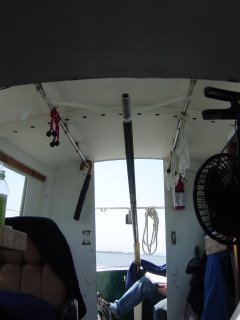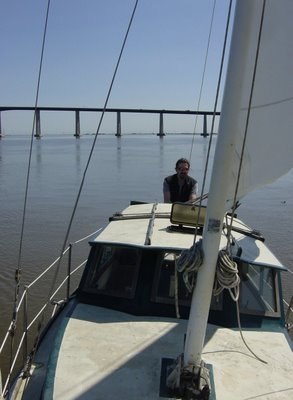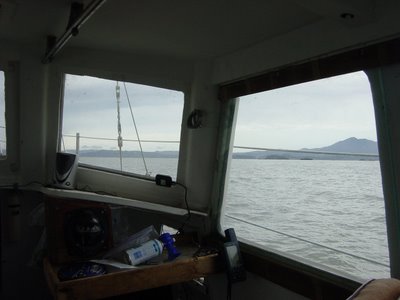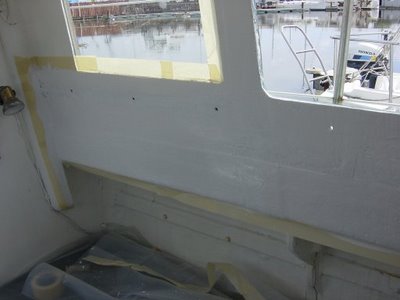


Our departure from San Francisco really began the previous day, with a trip to town to provision with victuals and a short jaunt to the gas dock to fill up a fuel jug. We slept soundly that night, awaiting our sunrise departure. At about 0730
(not quite sunrise, I know)I rolled out of bed, Raised the main in the almost calm air, and cast off lines.
The engine was running fine, but the boat seemed sluggish in reverse. Powering off the T slip, I became a little more than a little concerned when the propwash aft stopped and we started to drift down on a beautiful Knarr with our anchor leading the way toward the hand polished finish. "CIM!!! Need you on deck, right now" Cim bounced out of bed and was on deck before he knew it. We gently fended off and slowly gained way under the main, ghosting out of the harbor in the mirror smooth water.
The shear pin on the outboard had split, for reasons unknown. As we sailed across the bay, I replaced the pin and we began to motorsail across the shipping lanes into Raccoon Strait. About halfway through the strait the motor unexpectedly quit, and we ghosted the rest of the way through with help from the tide. After much head scratching, I decided that the motor worked fine at medium - low throttle settings, but would quit at higher settings after about 20 minutes. I ruled out fuel starvation - the obvious answer - and I'm still not sure why it doesn't like higher power settings. It could be just that it's thirty some years old, the pistons fit as tightly as a dime in a quarter roll, and it just doesn't feel up to it any more. Geriatric perogative - as long as you keep the throttle down it can go all day.
The wind began to fill in around 1030, and we ran wing and wing up through the San Pablo Straits with suprisingly little traffic to dodge. Our easy run continued through the afternoon, and we made to the mouth of the Carquinez exactly on time to make the tide. Putting Carquinez Strait behind us we reached North-Northeast to the spot in Honker bay where I had anchored on the way south, and settling in for the night we dropped the hook at 1700. Quietly, while we played cribbage, Loki slipped into the cabin unannounced.
Consulting the tide book, I saw that we could, if we left in an hour or so, make the tide change in new York slough (6 miles to the east) by sailing against the slowing current. The tide information cheerfully suggested that the tide would carry us through once we got there, and we might well enjoy a comfortable anchorage on Fraser Shoal for the night. All that progress for just a little night sailing, and besides it was a shame to waste the good wind. The forecast was for calm through the night, and weaker winds the next day. We were concerned that we might have trouble fighting our way upriver, and with the motor being so picky I thought maybe we should sail while we knew we could.
We pulled the hook as the current dropped to less than a knot, and we sailed strongly with the sunset at our back. Soon the darkness fell, as did the wind, and we made slow progress downwind.
I'm not sure when it was, exactly, that I began to refer to the tide book as the "book of wishes".
Despite rosy tide predictions, the current was turning against us. We slowed to half a knot, still a mile away from the fabled slough, and we could see (even in the dark) that we would not be soon entering the land of fair currents. I decided that we should bear north and head for Spoonbill creek for the night. It looked well protected, shoal at each end to keep anything too big out, and wide enough to anchor out of the channel. With the wind almost gone, as forecast, and Spoonbill creek flowing gently north, I felt good about our decision. After all, we may not have made Sherman Island, but we were closer than we were, and still enough time for 6 hours sleep before 0600. We anchored fore and aft with two anchors, bow to the mild current, and drifted off to the sound of frogs.
KaTHUMP!
I jumped out of my berth, and looked out aft to see us pinned against the rip-rap levee wall by a 5+ knot current from astern, and a 20 knot wind from the west. Briefly surveying the situation, I woke Cim and began to attempt an extrication. The rudder was jammed -I was not sure whether by debris or damage - but knowing how strong
Westward was built my money was on debris. I tied the stern anchor rode off to a float and cast it overboard.
Despite our attempts to swing toward the channel center, the jammed rudder and the relentless current conspired to pin us against a trash fence for a nearby aqueduct. It was 0130. High tide. We had to get off the levee wall, or we would be trapped as the tide went out. If we dried out here on the steep rip-rap wall, we would probably be tripped by our keel, fill and sink when the tide came in.
I directed Cim to tie the now slack main rode off to a corner post on the trash fence. With heroic effort, he dislodged us from the fence, and helped me warp ship until we hung by the bow from the post. I worked the rudder until the debris cleared, the unseen culprit washing cleanly away astern into the blackness of the night. With our spirits renewed along with our rudder, we motored up on the post, cast our line off it, and retrieved our anchor.
Confident that the current would hold at least for a while, we dropped the hook in the channel center and I maintained an anchor watch while Cim slept. I had the tiller tied over, and occasional adjustments kept us near the middle using the current to hold us against the wind.
As the current slackened, the wind increased. By 0315 I was unable to keep us away from the rocks, so I wakened Cim. We pulled the hook, retrieved our wayward stern anchor, and set out for Sherman Island with renewed faith in the "book of wishes".
You see, during my anchor watch, deep truths from the book were revealed to me. Following the still small voice from on high urging me to "read, read more!!!" , I discovered the tome of currents, the very scripture that would have foretold the ugly events of that early morning.
With faith renewed and wisdom increased, we used the now favorable currents and winds to easily fetch the anchorage off Sherman Island. Wide, protected enough, and with excellent holding, we knew that we would be secure for as long as we chose to stay. Armed with the knowledge that we could rest comfortably until our "ideal current" departure time of noon, we slept the sleep of the enlightened, and I dreamt of fair island maidens.

















































